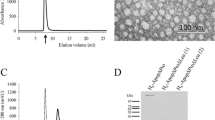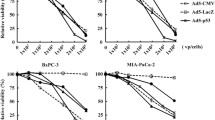Abstract
Biliary tract cancer, or cholangiocarcinoma, has a poor prognosis. Resection is the only curative treatment, but only a minority of patients are eligible. Chemotherapy and γ-irradiation are merely palliative, as they are unable to remove the malignancy completely. The chicken anemia virus-derived protein apoptin induces apoptosis in a wide range of human tumor cells and is not hindered by mutations inactivating p53 or by overexpression of Bcl-2, changes known to frustrate chemotherapy and radiation therapy. We examined whether apoptin kills human biliary tract cancer cells. Expression of apoptin by means of plasmids caused extensive cell death in three independent cholangiocarcinoma cell lines, CC-LP, CC-SW, and Mz-ChA-1, regardless of their oncogenic mutations, which included inactivated p16 and p53 and the disruption of the transforming growth factor β signaling pathway. In vitro delivery of apoptin by an adenoviral vector completely eradicated cholangiocarcinoma cells. Moreover, coexpression of the broad-spectrum caspase inhibitor p35 with apoptin only delayed the induced cell death. Changes in nuclear morphology still occurred early after transfection, and nuclei eventually disintegrated, suggesting that apoptin-induced cell death in these cells is not blocked by mutations in either the initiation or execution phase of apoptosis. The efficient induction of cell death by apoptin in cholangiocarcinoma cell lines makes apoptin an attractive candidate for molecular therapy of biliary tract cancer.




Similar content being viewed by others
Abbreviations
- CMV :
-
Cytomegalovirus
- DAPI :
-
2,4-Diamino-2-phenylindole
- DMEM :
-
Dulbecco’s modified Eagle’s medium
- MOI :
-
Multiplicity of infection
References
De Groen PC, Gores GJ, laRusso NF, Gunderson LL, Nagorney DM (1999) Biliary tract cancers. N Engl J Med 341:1368–1378
Byrnes V, Afdhal N (2002) Cholangiocarcinoma of the hepatic hilum (klatskin tumor). Curr Treat Options Gastroenterol 5:87–94
Kawarada Y, Yamagiwa K, Das BC (2002) Analysis of the relationships between clinicopathologic factors and survival time in intrahepatic cholangiocarcinoma. Am J Surg 183:679–685
Valverde A, Bonhomme N, Farges O, Sauvanet A, Flejou JF, Belghiti J (1999) Resection of intrahepatic cholangiocarcinoma: a Western experience. J Hepatobiliary Pancreat Surg 6:122–127
Cheng JL, Bruno MJ, Bergman JJ, Rauws EA, Tytgat GN, Huibregtse K (2002) Endoscopic palliation of patients with biliary obstruction caused by nonresectable hilar cholangiocarcinoma: efficacy of self-expandable metallic Wallstents. Gastrointest Endosc 56:33–39
Crane CH, Macdonald KO, Vauthey JN, Yehuda P, Brown T, Curley S, Wong A, Delclos M, Charnsangavej C, Janjan NA (2002) Limitations of conventional doses of chemoradiation for unresectable biliary cancer. Int J Radiat Oncol Biol Phys 53:969–974
Price P (2001) Cholangiocarcinoma and the role of radiation and chemotherapy. Hepatogastroenterology 48:51–52
Dive C (1997) Avoidance of apoptosis as a mechanism of drug resistance. J Intern Med Suppl 740:139–145
Hannun YA (1997) Apoptosis and the dilemma of cancer chemotherapy. Blood 89:1845–1853
Makin G, Dive C (2001) Apoptosis and cancer chemotherapy. Trends Cell Biol 11:S22–S26
Hanahan D, Weinberg RA (2000) The hallmarks of cancer. Cell 100:57–70
Aas T, Borresen AL, Geisler S, Smith-Sorensen B, Johnsen H, Varhaug JE, Akslen LA, Lonning PE (1996) Specific p53 mutations are associated with de novo resistance to doxorubicin in breast cancer patients. Nat Med 2:811–814
Findley HW, Gu L, Yeager AM, Zhou M (1997) Expression and regulation of Bcl-2, Bcl-xl, and Bax correlate with p53 status and sensitivity to apoptosis in childhood acute lymphoblastic leukemia. Blood 89:2986–2993
Noteborn MHM, Danen-van Oorschot AAAM, Van der Eb AJ (1998) The apoptin gene of chicken anemia virus in the induction of apoptosis in human tumorigenic cells and in gene therapy of cancer. Gene Ther Mol Biol 1:399–406
Danen-van Oorschot AAAM, Van der Eb AJ, Noteborn MHM (2000) The chicken anemia virus-derived protein apoptin requires activation of caspases for induction of apoptosis in human tumor cells. J Virol 74:7072–7078
Zhuang SM, Shvarts A, Jochemsen AG, van Oorschot AA, van der Eb AJ, Noteborn MHM (1995) Differential sensitivity to Ad5 E1B-21kD and Bcl-2 proteins of apoptin-induced versus p53-induced apoptosis. Carcinogenesis 16:2939–2944
Pietersen AM, van der Eb MM, Rademaker HJ, van den Wollenberg DJ, Rabelink MJ, Kuppen PJ, van Dierendonck JH, van Ormondt H, Masman D, van de Velde CJ, van der Eb AJ, Hoeben RC, Noteborn MH (1999) Specific tumor-cell killing with adenovirus vectors containing the apoptin gene. Gene Ther 6:882–892
Danen-van Oorschot AAAM, van der Eb AJ, Noteborn MHM (1999) Bcl-2 stimulates apoptin-induced apoptosis. Adv Exp Med Biol 457:245–249
Danen-van Oorschot AAAM, Zhang Y, Erkeland SJ, Fischer DF, van der Eb AJ, Noteborn MHM (1999) The effect of Bcl-2 on apoptin in ‘normal’ vs transformed human cells. Leukemia 13 [Suppl 1]:S75–S77
Zhuang SM, Shvarts A, van Ormondt H, Jochemsen AG, van der Eb AJ, Noteborn MHM (1995) Apoptin, a protein derived from chicken anemia virus, induces p53-independent apoptosis in human osteosarcoma cells. Cancer Res 55:486–489
Danen-van Oorschot AAAM, Fischer DF, Grimbergen JM, Klein B, Zhuang S, Falkenburg JH, Backendorf C, Quax PH, van der Eb AJ, Noteborn MHM (1997) Apoptin induces apoptosis in human transformed and malignant cells but not in normal cells. Proc Natl Acad Sci U S A 94:5843–5847
Zhang Y-H, Leliveld SR, Kooistra K, Molenaar C, Rohn JL, Tanke HJ, Abrahams JP, Noteborn MHM (2003) Recombinant apoptin multimers kill tumor cells but are nontoxic and epitope-shielded in a normal-cell-specific fashion. Exp Cell Res 289:36–46
Shimizu Y, Demetris AJ, Gollin SM, Storto PD, Bedford HM, Altarac S, Iwatsuki S, Herberman RB, Whiteside TL (1992) Two new human cholangiocarcinoma cell lines and their cytogenetics and responses to growth factors, hormones, cytokines or immunologic effector cells. Int J Cancer 52:252–260
Knuth A, Gabbert H, Dippold W, Klein O, Sachsse W, Bitter-Suermann D, Prellwitz W, Meyer zum Buschenfelde KH (1985) Biliary adenocarcinoma. Characterisation of three new human tumor cell lines. J Hepatol 1:579–596
Fallaux FJ, Bout A, van der Velde I, van den Wollenberg DJ, Hehir KM, Keegan J, Auger C, Cramer SJ, van Ormondt H, van der Eb AJ, Valerio D, Hoeben RC (1998) New helper cells and matched early region 1-deleted adenovirus vectors prevent generation of replication-competent adenoviruses. Hum Gene Ther 9:1909–1917
Fallaux FJ, Kranenburg O, Cramer SJ, Houweling A, van Ormondt H, Hoeben RC, van der Eb AJ (1996) Characterization of 911: a new helper cell line for the titration and propagation of early region 1-deleted adenoviral vectors. Hum Gene Ther 7:215–222
Menke AL, Shvarts A, Riteco N, van Ham RC, van der Eb AJ, Jochemsen AG (1997) Wilms’ tumor 1-KTS isoforms induce p53-independent apoptosis that can be partially rescued by expression of the epidermal growth factor receptor or the insulin receptor. Cancer Res 57:1353–1363
Steegenga WT, Van Laar T, Shvarts A, Terleth C, Van der Eb AJ, Jochemsen AG (1995) Distinct modulation of p53 activity in transcription and cell cycle regulation by the large (54 kDa) and the small (21 kDa) adenovirus E1B proteins. Virology 212:543–554
van den Heuvel SJ, van Laar T, Kast WM, Melief CJ, Zantema A, van der Eb AJ (1990) Association between the cellular p53 and the adenovirus 5 E1B-55kd proteins reduces the oncogenicity of Ad-transformed cells. EMBO J 9:2621–2629
Eb MM van der, Pietersen AM, Speetjens FM, Kuppen PJ, van de Velde CJ, Noteborn MH, Hoeben RC (2002) Gene therapy with apoptin induces regression of xenografted human hepatomas. Cancer Gene Ther 9:53–61
Graham FL, Prevec L (1995) Methods for construction of adenovirus vectors. Mol Biotechnol 3:207–220
Caca K, Feisthammel J, Klee K, Tannapfel A, Witzigmann H, Wittekind C, Mossner J, Berr F (2002) Inactivation of the INK4a/ARF locus and p53 in sporadic extrahepatic bile duct cancers and bile tract cancer cell lines. Int J Cancer 97:481–488
Yazumi S, Ko K, Watanabe N, Shinohara H, Yoshikawa K, Chiba T, Takahashi R (2000) Disrupted transforming growth factor-beta signaling and deregulated growth in human biliary tract cancer cells. Int J Cancer 86:782–789
Okuda K, Nakanuma Y, Miyazaki M (2002) Cholangiocarcinoma: recent progress. II Molecular pathology and treatment. J Gastroenterol Hepatol 17:1056–1063
Moll UM, Erster, S, Zaika A (2001) p53, p63 and p73–slos, alliances and feuds among family members. Biochim Biophys Acta 1552:47–59
Pederson LC, Vickers SM, Buchsbaum DJ, Kancharla SR, Mayo MS, Curiel DT, Stackhouse MA (1998) Combined cytosine deaminase expression, 5-fluorocytosine exposure, and radiotherapy increases cytotoxicity to cholangiocarcinoma cells. J Gastrointest Surg 2:283–291
Pederson LC, Buchsbaum DJ, Vickers SM, Kancharla SR, Mayo MS, Curiel DT, Stackhouse MA (1997) Molecular chemotherapy combined with radiation therapy enhances killing of cholangiocarcinoma cells in vitro and in vivo. Cancer Res 57:4325–4332
Zhou Q, Krebs JF, Snipas SJ, Price A, Alnemri ES, Tomaselli KJ, Salvesen GS (1998) Interaction of the baculovirus anti-apoptotic protein p35 with caspases. Specificity, kinetics, and characterization of the caspase/p35 complex. Biochemistry 37:10757–10765
Stennicke HR, Ryan CA, Salvesen GS (2002) Reprieval from execution: the molecular basis of caspase inhibition. Trends Biochem Sci 27:94–101
Van Cruchten S, Van Den BW (2002) Morphological and biochemical aspects of apoptosis, oncosis and necrosis. Anat Histol Embryol 31:214–223
Hirsch T, Marchetti P, Susin SA, Dallaporta B, Zamzami N, Marzo I, Geuskens M, Kroemer G (1997) The apoptosis-necrosis paradox. Apoptogenic proteases activated after mitochondrial permeability transition determine the mode of cell death. Oncogene 15:1573–1581
McCarthy NJ, Whyte MK, Gilbert CS, Evan GI (1997) Inhibition of Ced-3/ICE-related proteases does not prevent cell death induced by oncogenes, DNA damage, or the Bcl-2 homologue Bak. J Cell Biol 136:215–227
Peeters MJ, Patijn GA, Lieber A, Meuse L, Kay MA (1996) Adenovirus-mediated hepatic gene transfer in mice: comparison of intravascular and biliary administration. Hum Gene Ther 7:1693–1699
Cheifetz RE, Davis NL, Owen DA (1996) An animal model of benign bile-duct stricture, sclerosing cholangitis and cholangiocarcinoma and the role of epiderma growth factor receptor in ductal proliferation. Can J Surg 39:193–197
Acknowledgements
We thank Piter Bosma (Amsterdam Medical Center) for stimulating discussions and Aart-Gerrit Jochemsen (Leiden University Medical Center) for helpful advise and for the kind donation of the vectors pOLXALuc and pXAluc.
Author information
Authors and Affiliations
Corresponding author
Additional information
A.M. Pietersen and S.A. Rutjes contributed equally to this manuscript
Rights and permissions
About this article
Cite this article
Pietersen, A.M., Rutjes, S.A., van Tongeren, J. et al. The tumor-selective viral protein apoptin effectively kills human biliary tract cancer cells. J Mol Med 82, 56–63 (2004). https://doi.org/10.1007/s00109-003-0486-z
Received:
Accepted:
Published:
Issue Date:
DOI: https://doi.org/10.1007/s00109-003-0486-z




